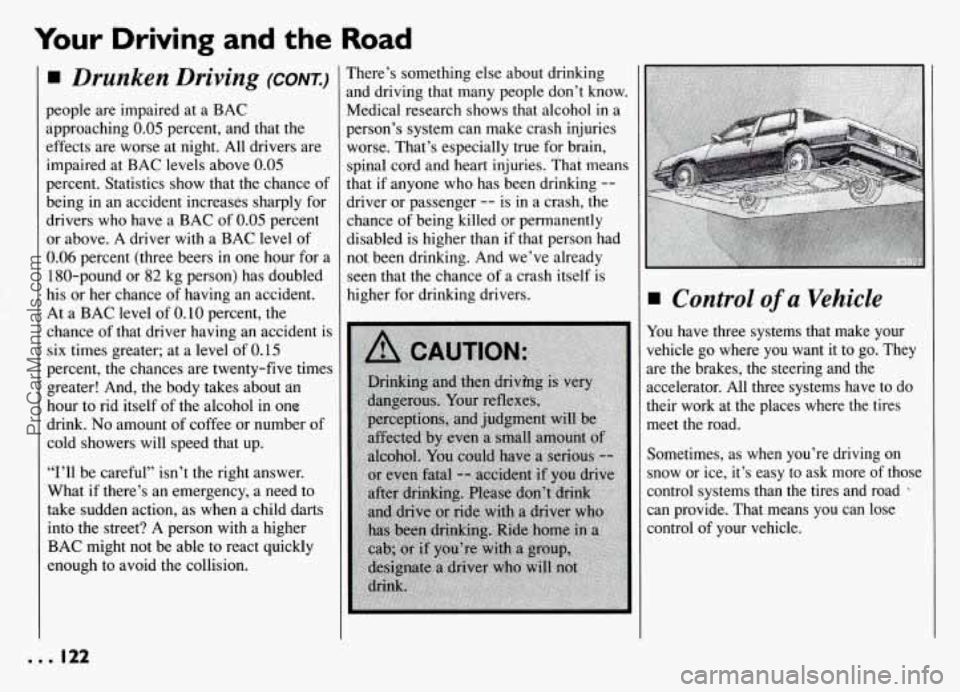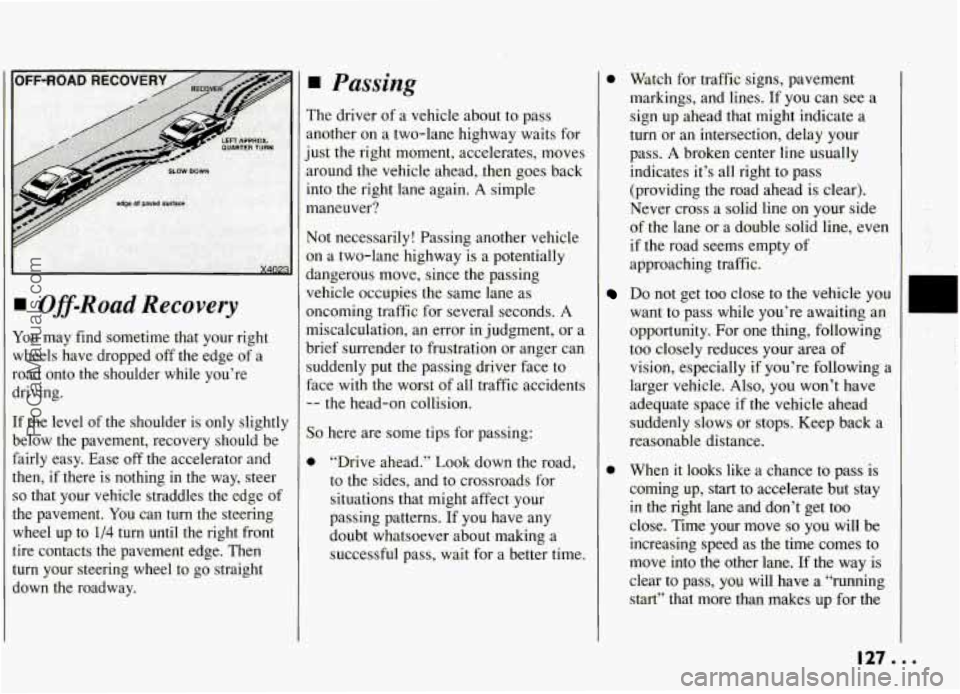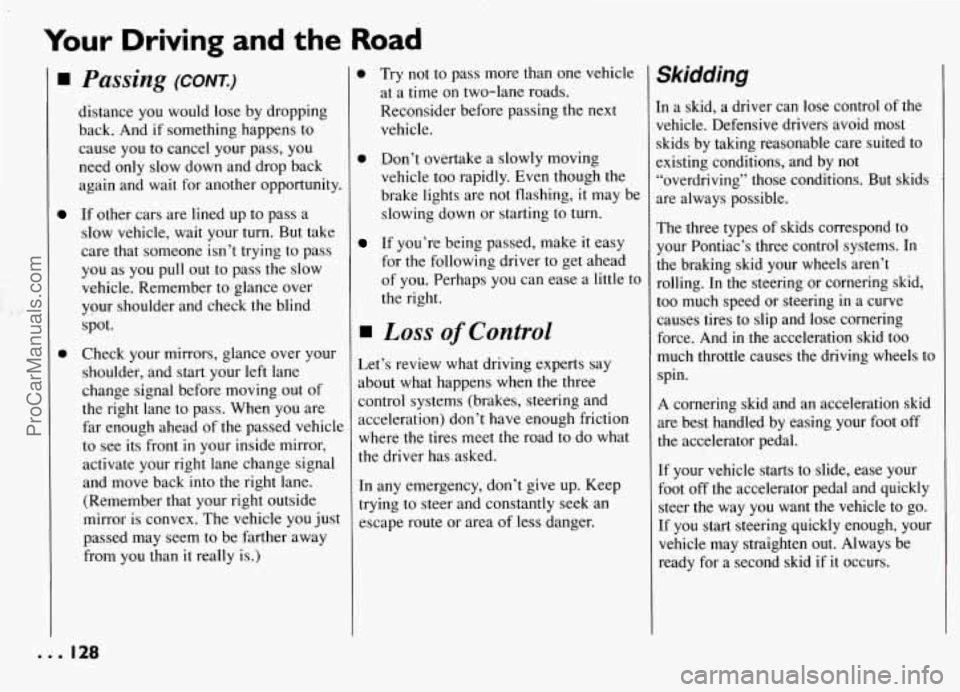1994 PONTIAC GRAND-AM ESP
[x] Cancel search: ESPPage 17 of 274

Seats & Restraint Systems
Here Are Questions
Many People
Ask
About Safety Belts --
and the Answers (CONT.)
Q: Why don’t they just put in air bags
so people won’t have to wear safety
belts?
A: Air bags, or Supplemental Restraint
Systems, are
in some vehicles today
and
will be in more of them in the
future. But they are supplemental
systems only
-- so they work with
safety belts, not instead of them.
Every air bag system ever offered for
sale has required the use of safety
belts. Even
if you’re in a vehicle that
has air bags, you
still have to buckle
up to get the most protection. That’s
true not only
in frontal collisions, but
especially
in side and other collisions.
Q: If I’m a good driver, and I never
drive far from home, why should I
wear safety belts?
A: You may be an excellent driver, but if
you’re in an accident -- even one that
isn’t your fault
-- you and your
passengers can be hurt. Being a good
driver doesn’t protect you from things
beyond your control, such as bad
drivers.
Most accidents occur within 25 miles
(40 km) of home. And the greatest number
of serious injuries and deaths occur at
speeds of less than
40 mph (65 km/h).
Safety belts are for everyone.
Safety Belt Warning Light
When the key is turned to “Run” or
“Start”, a chime
will come on for about
eight seconds to remind people to fasten
their safety belts, unless the driver’s safety belt is already buckled. The safety
belt
light will also come on and stay on
for 20 seconds, then it will flash for an
additional
55 seconds. If the driver’s belt
is already buckled, neither the chime nor
the light will come on.
... 16
ProCarManuals.com
Page 25 of 274

Seats & Restraint Systems
How The Air Bag System
Works (CONT)
What will you see after an air bag
inflation?
After the air bag has inflated, it will then
quickly deflate, This occurs
so quickly
that some people may not even realize
that the air bag inflated. Some
components of the air bag module
in the
steering wheel hub may be hot for a short
time, but the portion of the bag that comes
into contact with you will not be hot to
the touch. There will be small amounts of
smoke and dust coming from vents in the
deflated air bag. The air bag will
not
impede the driver’s vision or ability to
steer the vehicle, nor will it hinder the
occupants from exiting the vehicle.
0 The air bag is designed to inflate only
once. After it inflates, you’ll need
some new parts for your air bag
system. If you don’t get them, the air
bag system won’t be there to help
protect you in another crash.
A new
system will include the air bag module
and possibly other parts. The service
manual has information about the
need to replace other parts.
Your vehicle is equipped with a
diagnostic module, which records
information about the air bag system
if the air bag deploys during a crash.
The module records information about
the readiness .of the system, which
sensors activated the deployment, and
whether the driver’s safety belt was in
use.
Let only qualified technicians work on
your air bag system. Improper service
can mean that your air bag system
won’t work properly. See your dealer
for service.
NOTICE:
If you damage the cover for the
driver’s air bag, it may not work
properly. You may have to replace
the air bag on the steering wheel.
Do not open or break the air bag
cover.
Is the smoke from an air bag inflation
harmful?
The particles emitted during air bag
inflation are not harmful to most people.
Some people with respiratory ailments
may experience difficulty breathing if
they’stay in the vehicle with the windows
closed’after air bag inflation.
So, if your
air bag inflates, you and any passengers
should exit the vehicle if and when it is
safe’to do
so. If you or your passengers
can’t get out of the vehicle, try to get
fresh air by opening a window, turning on
the fan, or opening
a door.
... 24
ProCarManuals.com
Page 53 of 274

Features & Controls
Battery Replacement
(CONK)
To Replace Batteries in the Remote
Keyless Entry:
1. Remove the screw from back cover.
2. Lift the front cover off, bottom half
first.
3. Remove and replace the two batteries
(2016).
4. Reassemble the transmitter.
5. Check the transmitter operation.
Tailgate Caution
. . 52
Theft
Vehicle theft is big business, especially in
some cities. Although your Pontiac has a
number of theft deterrent features, we
know that nothing we put on
it can make
it impossible to steal. However, there are
ways you can help.
Key in the Ignition
If you walk away from your vehicle with
the keys inside, it’s an easy target for joy
riders or professional thieves
-- so don’t
do
it.
When you park your Pontiac and open the
driver’s door, you’ll hear a chime
reminding you to remove your key from
the ignition and take
it with you. Always
do this. Your steering wheel will be
locked, and
so will your ignition. If you
have an automatic transaxle, taking your
key out also locks your transaxle. And
remember to lock the doors.
Parking at Night
Park in a lighted spot, close all windows
and lock your vehicle. Remember to keep
your valuables out of sight. Put them
in a
storage area, or take them with you.
ProCarManuals.com
Page 78 of 274

rn Light Controls
Parking Lights:
Rotate the switch up to PC to turn on:
Parking Lights
0 Side Marker Lights
Taillights
Instrument Panel Lights
Headlights:
Rotate the switch to ’ , to turn on:
0 Headlights
0 Parking Lights
0 Side Marker Lights
0 Taillights
0 Instrument Panel Lights
Rotate the switch
to OFF to turn all the
lights off.
-‘a-
Operation of Lights
Although your vehicle’s lighting system
(headlights, parking lights, fog lamps,
side marker lights and taillights)
meet all
applicable federal lighting requirements,
certain states and provinces may apply
their own lighting regulations that may
require special attention before you
operate these lights.
For example, some jurisdictions may
require that you operate your lower beam
lights with fog lamps at all times, or that
headlights be turned
on whenever you
must use your windshield wipers.
In
addition, most jurisdictions prohibit
driving solely with parking lights,
especially at dawn or dusk.
It is
recommended that you check with your
own state or provincial highway authority
for applicable lighting regulations.
Lights On Reminder
If you open the driver’s door while
leaving the lights
on, you will hear a
warning chime.
Daytime Running Lights
(CANADA ONLY)
Your DRL work with a light sensor on top
of the instrument panel. Don’t cover
it up.
The high beam headlights will come
on at
reduced brightness in daylight when:
0 The ignition is on
0 The headlight switch is off, and
0 The parking brake is released on a
manual transaxle; or
77 a I
ProCarManuals.com
Page 118 of 274

To Unlock the System After a Power
Loss:
When battery power is reapplied to a
secured audio system after
a loss of
power, the audio system
will not turn on
and LOC will appear on the digital
display.
You will need to unlock the
Delco LOC II@ system.
1. Turn the ignition to the ACCESSORY
or
RUN position, and turn the radio
off.
2. Press SET, and 000 will appear on the
display.
3. Follow steps 4-8 for disabling your
anti-theft system.
4. Press the lower knob. The time will
appear on the digital display if you are
successful. If SEC appears, however,
the numbers did not match
and your
audio system is still locked.
Understanding Radio
Reception
FM Stereo
FM stereo will give you the best sound,
but FM signals
will reach only about 10
to
40 miles (16 to 65 km). Tall buildings
or hills can interfere
with FM signals,
causing the sound to come and go.
AM
The range for most AM stations is greater
than for
FM, especially at night. The
longer range, however, can cause stations
to interfere
with each other. AM can also
pick
up noise from things like storms and
power lines. To lower this noise,
try
reducing the treble level.
Care of Your Cassette
Tape Player
A tape player that is not cleaned regularly
can cause reduced sound quality, ruined
cassettes, or a damaged mechanism.
Cassette tapes should be stored
in their
cases away from contaminants, direct
sunlight, and extreme heat. If they aren’t,
they may not operate properly or cause
failure of the tape player.
Your tape player should be cleaned after
every 50 hours of use. If you notice a
reduction
in sound quality, try a known
good cassette
to see if the tape or the tape
player is at fault. If this other cassette has
no improvement
in sound quality, clean
the tape player.
Cleaning may be done with a scrubbing
action, non-abrasive cleaning cassette.
This system uses a cleaning cassette with
pads which scrub the tape head as the
hubs of the cleaner cassette turn. It is
normal for the cartridge to eject while
cleaning. Insert the cassette at least
3
times to ensure thorough cleaning. A
scrubbing action cleaning cassette is
available through your Pontiac dealership.
117...
ProCarManuals.com
Page 123 of 274

Your Driving and the Road
Drunken Driving (CONTI
people are impaired at a BAC
approaching
0.05 percent, and that the
effects are worse at night. All drivers are
impaired at BAC levels above
0.05
percent. Statistics show that the chance of
being in an accident increases sharply for
drivers who have a BAC of
0.05 percent
or above. A driver with a BAC level of
0.06 percent (three beers in one hour for a
180-pound or
82 kg person) has doubled
his or her chance of having an accident.
At a BAC level of
0.10 percent, the
chance of that driver having an accident is
six times greater; at a level of 0.15
percent, the chances are twenty-five times
greater! And, the body takes about an
hour to rid itself of the alcohol in on@
drink.
No amount of coffee or number of
cold showers will speed that up.
“I’ll be careful” isn’t the right answer.
What if there’s an emergency, a need to
take sudden action, as when a child darts
into the street? A person with a higher
BAC might not be able to react quickly
enough to avoid the collision.
There’s something else about drinking
and driving that many people don’t know.
Medical research shows that alcohol in a
person’s system can make crash injuries
worse. That’s especially true for brain,
spinal cord and heart injuries. That means
that if anyone who has been drinking
--
driver or passenger -- is in a crash, the
chance of being killed or permanently
disabled
is higher than if that person had
not. been drinking. And we’ve already
seen that the chance of a crash itself is
higher for drinking drivers.
Control of a Vehicle
You have three systems that make your
vehicle
go where you want it to go. They
are the brakes, the steering and the
accelerator. All three systems have to do
their work at the places where the tires meet the road.
Sometimes, as when you’re driving on
snow or ice, it’s easy
to ask more of those
control systems than the tires and road
a
can provide. That means you can lose
control of your vehicle.
ProCarManuals.com
Page 128 of 274

Off-Road Recovery
You may find sometime that your right
wheels have dropped’off the edge of a
road onto the shoulder while you’re
driving.
If the level of the shoulder is only slightlJ
below the pavement, recovery should be fairly easy. Ease off the accelerator and
then, if there is nothing in the way, steer
so that your vehicle straddles the edge of
the pavement.
You can turn the steering
wheel up to
1/4 turn until the right front
tire contacts the pavement edge. Then
turn your steering wheel to go straight
down the roadway.
<
1
(
I
I
1
7
4 Passing
The driver of a vehicle about to pass
another on
a two-lane highway waits for
just the right moment, accelerates, moves
around the vehicle ahead, dhen goes back
into the right lane again.
A simple
maneuver?
Not necessarily! Passing another vehicle
on a two-lane highway is a potentially
dangerous move, since the passing
vehicle occupies the same lane as
oncoming traffic for several seconds.
A
miscalculation, an error in judgment, or a
brief surrender
to frustration or anger can
suddenly put the passing driver face to
face with the worst of all traffic accidents
-- the head-on collision.
So here are some tips for passing:
0 “Drive ahead.” Look down the road,
to the sides, and to crossroads for
situations that might affect your
passing patterns. If you have any
doubt whatsoever about making a
successful pass, wait for
a better time.
0
0
Watch for traffic signs, pavement
markings, and lines. If you can see a
sign up ahead that might indicate a
turn or an intersection, delay your
pass.
A broken center line usually
indicates it’s all right to pass
(providing the road ahead is clear).
Never cross a solid line on your side
of the lane or a double solid line, even
if the road seems empty
of
approaching traffic.
Do not get too close to the vehicle you
want to pass while you’re awaiting an
opportunity. For one thing, following
too closely reduces your area of
vision, especially if you’re following a
larger vehicle. Also, you won’t have
adequate space if the vehicle ahead
suddenly slows or stops. Keep back a
reasonable distance.
When it looks like a chance to pass is
coming up, start to accelerate but stay
in the right lane and don’t get too
close. Time your move
so you will be
increasing speed as the time comes to
move into the other lane. If the way is
clear to pass, you will have a “running
start” that more than makes up for the
127...
ProCarManuals.com
Page 129 of 274

Your Driving and the Road
I
0
Passing (CONT.)
distance you would lose by dropping
back. And if something happens to
cause you to cancel your pass, you
need only slow down and drop back
again and wait for another opportunity.
If other cars are lined up to pass a
slow vehicle, wait your turn. But take
care that someone isn’t trying to pass
you as you pull out to pass the slow
vehicle. Remember to glance over
your shoulder and check the blind
spot.
Check your mirrors, glance over your
shoulder, and start your left lane
change signal before moving out of
the right lane to pass. When you are
far enough ahead of the passed vehicle
to see its front
in your inside mirror,
activate your right lane change signal
and move back into the right lane.
(Remember that your right outside
mirror is convex. The vehicle you just
passed may seem to be farther away
from you than
it really is.)
B Try not to pass more than one vehicle
at a time on two-lane roads.
Reconsider before passing the next
vehicle.
B Don’t overtake a slowly moving
vehicle too rapidly. Even though the
brake lights are not flashing, it may be
slowing down or starting to
turn.
If you’re being passed, make it easy
for the following driver to get ahead
of you. Perhaps you can ease a
little to
the right.
Loss of Control
Let’s review what driving experts say
about what happens when the three
control systems (brakes, steering and
acceleration) don’t have enough friction
where the tires meet
the road to do what
the driver has asked.
In any emergency, don’t give up. Keep
trying to steer and constantly seek an
escape route or area of less danger.
Skidding
[n a skid, a driver can lose control of the
vehicle. Defensive drivers avoid most
skids by taking reasonable care suited to
:xisting conditions, and by not
,‘overdriving” those conditions. But skids
we always possible.
The three types of skids correspond to
your Pontiac’s three control systems. In
the braking skid your wheels aren’t
rolling. In the steering or cornering skid,
too much speed or steering in a curve
causes’tires to slip and lose cornering
force. And in the acceleration skid too
much throttle causes the driving wheels to
spin.
A cornering skid and an acceleration skid
are best handled by easing your foot off
the accelerator pedal.
If your vehicle starts to slide, ease your
foot off the accelerator pedal and quickly
steer the way you want the vehicle to go.
If you start steering quickly enough, your
vehicle may straighten out. Always be
ready for a second skid if
it occurs.
... 128
ProCarManuals.com